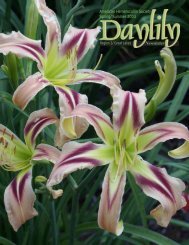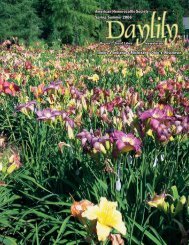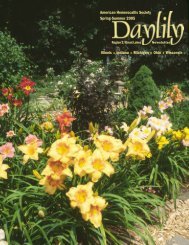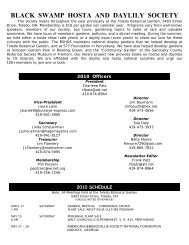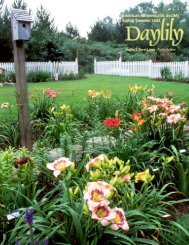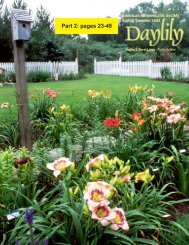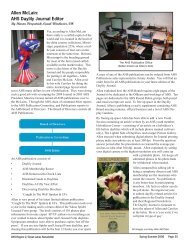Pages - AHS Region 2
Pages - AHS Region 2
Pages - AHS Region 2
You also want an ePaper? Increase the reach of your titles
YUMPU automatically turns print PDFs into web optimized ePapers that Google loves.
<strong>AHS</strong> <strong>Region</strong> 2/Great Lakes Newsletter<br />
A Collection of Tribut<br />
ributes to R. William Munson, Jr.<br />
After a message telling of the passing of one of greatest and most well-known daylily hybridizers came across the<br />
computer screens of our <strong>AHS</strong> E-mail Robin members on October 3, 1999, a great outpouring of feelings began. Within<br />
minutes and hours, over one thousand <strong>AHS</strong> members read about this irreversible event, and daylily devotees from all<br />
parts of North America and many parts of the world shared their thoughts and memories of this great man so freely<br />
over the next few days. Here, with each writer's permission and with only a slight bit of editing, are some of their<br />
spontaneous feelings put into words.<br />
<strong>AHS</strong> E-mail Robin Member Gisela Meckstroth<br />
From: Pam Erikson <br />
To: DAYLILY@MAELSTROM.STJOHNS.EDU<br />
Date: Sunday, October 03, 1999 8:24 PM<br />
Subject: Mr. Munson<br />
Hi all:<br />
It was with great sadness that I read about Bill Munson tonight.<br />
For as long as I can remember, HIS was the name first and<br />
foremost in my mind whenever anyone asked me about the<br />
truly important steps made in hybridizing. His contributions to<br />
the daylily world will live on forever in all of our gardens, and<br />
his cultivars will be used in many more generations of daylilies<br />
yet to come. My deepest sympathies to all his family and<br />
friends who are mourning this tragic loss.<br />
Pam Erikson, B.C. Canada - <strong>Region</strong> 8, zone 7<br />
To all,<br />
From: Bob Roycroft <br />
To: DAYLILY@MAELSTROM.STJOHNS.EDU<br />
Date: Wednesday, October 06, 1999 12:31 AM<br />
Subject: Bill Munson<br />
Thank you all for the posts concerning Bill Munson. I have only<br />
met him through what I have read and heard and through some<br />
of his fabulous daylilies—we currently grow 22 of his introductions<br />
and all of these reportedly grow well over a wide range of<br />
climate zone; no wimps in these 22! We and our staff routinely<br />
make a blanket statement to our cold-climate, walk-in customers<br />
that the 20 Munson evergreens we currently offer should do<br />
well for them. This blanket statement concerning evergreens is<br />
made only for Bill Munson’s evergreens—not for any other<br />
hybridizer’s. I’ve heard stories about how this great Florida hybridizer<br />
approached breeding for cold hardiness but it is second<br />
and third hand info. Could some knowledgeable person share the<br />
true story with the Robin and also mention those who were instrumental<br />
in assisting him in accomplishing this cold hardiness<br />
with so many of his evergreens<br />
I stood in our garden on yesterday’s October morning and had<br />
some quiet time just looking at a clump of Bill Munson’s famous<br />
OLIVE BAILEY LANGDON (1974) in a display bed with<br />
three blooming scapes and four new scapes emerging. It is special<br />
to see such performance so late in the year; visiting with<br />
one of his intros, in its full glory, was extra special. (I also recalled<br />
that it was Ra Hansen who first recommended OLIVE<br />
BAILEY LANGDON to me for its showy very early bloom, and,<br />
then for its showy very late bloom.)<br />
My absolute favorite Munson cultivar is AFRICAN GRAPE—a<br />
1991 registration. I am amazed that Eureka lists only six growers<br />
who offer it. AFRICAN GRAPE is robust with the most beautiful<br />
foliage imaginable; a good increaser; great branching and<br />
bud count on its sturdy 28" tall scapes; a cold-hardy evergreen;<br />
and, the 6" rich claret purple blooms are sunfast! This daylily<br />
has “Stout” written all over it, in my opinion, and to my knowledge<br />
has not had the necessary distribution and exposure to even<br />
win a lesser award. (Someone please correct me if I am mistaken.)<br />
The lack of recognition is probably largely due to the fact that its<br />
first (of several) scapes start blooming in late mid-season—approximately<br />
7-10 days after most <strong>Region</strong>als and the National (as<br />
is the case with many “unknown” greats).<br />
Clarence and Beth Crochet visited our nursery in July. Clarence<br />
was so impressed with AFRICAN GRAPE that he left with three<br />
multiple-fan three-gallon pots of it! So, soon Eureka will have<br />
another grower who offers it. Great! I’m sure that Clarence and<br />
Beth will do a fantastic job in helping to promote and spread this<br />
wonderful introduction of Bill’s to many. Maybe it will soon be<br />
universally recognized for the great daylily it is! (We shortly plan<br />
to have AFRICAN GRAPE as the “Featured Cultivar of the Week”<br />
on our new web site which came on line last Sunday.<br />
Bill Munson, your presence will be felt each summer for decades<br />
to come in all of our gardens whether we had the pleasure of personally<br />
meeting you or not. Thanks for the pleasure you give us!<br />
Sincerely,<br />
Bob Roycroft, Roycroft Daylily Nursery<br />
Georgetown, SC (lower zone 8)<br />
Nursery e-mail: rdn@sccoast.net<br />
http://www.roycroftdaylilies.com<br />
From: Jeanne Norris<br />
<br />
To: DAYLILY@MAELSTROM.STJOHNS.EDU<br />
Date: Tuesday, October 05, 1999 3:11 PM<br />
Subject: Bill Munson, we will miss you.<br />
If you never had the opportunity to meet Bill Munson, you may<br />
still be the recipient of his God given talents in hybridizing<br />
daylilies. He was a master of his “trade”. Munson cultivars are<br />
grown in all sections of the world.<br />
The first time I heard his name was in the early 1960’s. When I<br />
would make my yearly pilgrimages to Ophelia Taylor’s garden,<br />
just outside of Silver Springs. She always had such high praise<br />
for Bill Munson. Bill, she explained, was a young man in<br />
Gainesville who was doing great things in his hybridizing program<br />
with daylilies. She also spoke very highly of his mother,<br />
Ida. We were growing TOVARICH (1965), a beautiful dark red<br />
daylily, hybridized by R. Munson. Ophelia was quick to correct<br />
me and told me, he was the Senior and Bill was the Junior. We<br />
were friends with another hybridizer who lived in DeLand, named<br />
Connie Fleishel. Connie was a protegee of both, Bill and Ophelia.<br />
We would be visiting her garden, and sometimes, she would have<br />
to leave to meet the Greyhound bus. Bill had telephoned earlier<br />
that day and said he was sending her some special pollen. She<br />
had to rush to meet the bus, pick it up her priceless package, and<br />
put in the refrigerator to use for the next days crosses. Bill named<br />
a special cultivar for her, ALENE CONSTANCE FLEISHEL<br />
(1968).<br />
Our first trip to the Munson garden was at their home across the<br />
“tracks” from Shands Hospital. Bill & I invited Ed & Mary Helen<br />
(continued next page)<br />
Page 14 Spring/Summer 2000



